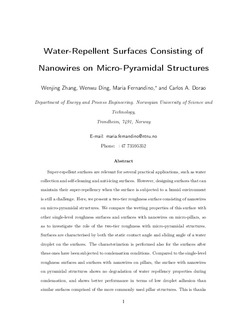| dc.contributor.author | Zhang, Wenjing | |
| dc.contributor.author | Ding, Wenwu | |
| dc.contributor.author | Fernandino, Maria | |
| dc.contributor.author | Dorao, Carlos Alberto | |
| dc.date.accessioned | 2020-01-28T12:57:24Z | |
| dc.date.available | 2020-01-28T12:57:24Z | |
| dc.date.created | 2020-01-13T22:21:31Z | |
| dc.date.issued | 2019 | |
| dc.identifier.citation | ACS Applied Nano Materials. 2019, 2 7696-7704. | nb_NO |
| dc.identifier.issn | 2574-0970 | |
| dc.identifier.uri | http://hdl.handle.net/11250/2638366 | |
| dc.description.abstract | Super-repellent surfaces are relevant for several practical applications, such as water collection and self-cleaning and anti-icing surfaces. However, designing surfaces that can maintain their super-repellency when the surface is subjected to a humid environment is still a challenge. Here, we present a two-tier roughness surface consisting of nanowires on micropyramidal structures. We compare the wetting properties of this surface with other single-level roughness surfaces and surfaces with nanowires on micropillars, so as to investigate the role of the two-tier roughness with micropyramidal structures. Surfaces are characterized by both the static contact angle and sliding angle of a water droplet on the surfaces. The characterization is performed also for the surfaces after these ones have been subjected to condensation conditions. Compared to the single-level roughness surfaces and surfaces with nanowires on pillars, the surface with nanowires on pyramidal structures shows no degradation of water repellency properties during condensation, and shows better performance in terms of low droplet adhesion than similar surfaces composed of the more commonly used pillar structures. This is thanks to the nanowires’ roughness that minimizes the contact area of the droplets with the base surface and the V-shaped cavities between the pyramids that provide the droplets with an upward driving force due to Laplace pressure. Furthermore, this study shows the importance of characterizing surface wetting properties not only on dry but also on wet conditions. The combination of a nanoscale roughness with micropyramidal structures appears as an attractive solution for super-repellent substrates under humid and wet conditions. | nb_NO |
| dc.language.iso | eng | nb_NO |
| dc.publisher | American Chemical Society | nb_NO |
| dc.title | Water-repellent surfaces consisting of nanowires on micro-pyramidal structures | nb_NO |
| dc.type | Journal article | nb_NO |
| dc.type | Peer reviewed | nb_NO |
| dc.description.version | acceptedVersion | nb_NO |
| dc.source.pagenumber | 7696-7704 | nb_NO |
| dc.source.volume | 2 | nb_NO |
| dc.source.journal | ACS Applied Nano Materials | nb_NO |
| dc.identifier.doi | 10.1021/acsanm.9b01767 | |
| dc.identifier.cristin | 1771910 | |
| dc.description.localcode | Locked until 27.11.2020 due to copyright restrictions. This document is the Accepted Manuscript version of a Published Work that appeared in final form in [JournalTitle], copyright © American Chemical Society after peer review and technical editing by the publisher. To access the final edited and published work see https://doi.org/10.1021/acsanm.9b01767 | nb_NO |
| cristin.unitcode | 194,64,25,0 | |
| cristin.unitname | Institutt for energi- og prosessteknikk | |
| cristin.ispublished | true | |
| cristin.fulltext | postprint | |
| cristin.qualitycode | 1 | |
